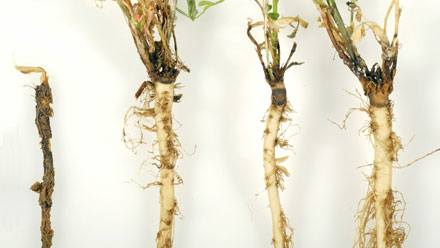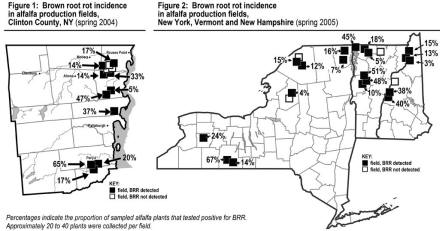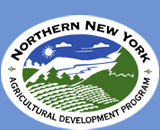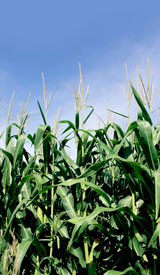June 23, 2010
Contacts: See list at end of release
Northern NY is Eastern U.S. Center for Brown Root Rot Research

Northern New York has become a significant center for research on brown
root rot, the soil-borne fungus causing root and crown rot of alfalfa,
other perennial legumes, and overwintering grasses. The fungus Phoma
sclerotioides, associated with yield loss, winterkill, slow crop
emergence after winter dormancy, and stand decline, was first detected
in the eastern U.S. in a Clinton County (Northern NY) alfalfa field in
2003.
With small grants funding from the farmer-driven Northern New York
Agricultural Development Program, Cornell University established
research trials and a BRR-resistant alfalfa nursery program at the W.H.
Miner Agricultural Research Institute at Chazy, NY.
“Because the Cornell-managed BRR test plots at the Miner Institute
contain natural populations of all five subtypes of the BRR fungus that
occur in eastern North America, the Northern New York site is an ideal
location for evaluating alfalfa germplasm for BRR resistance,” says BRR
project leader Gary C. Bergstrom, a Cornell Plant Pathologist.
“I believe the research plots at Chazy are the only ones in the eastern
U.S. that have been inoculated with the BRR fungus,” he adds. “The
research being conducted in Northern New York is critical to helping
farmers manage brown root rot by identifying resistant varieties.”
Preliminary research suggests that alfalfa cultivars resistant to one
subtype of the fungus may be susceptible to other subtypes.
At least seven genetically distinct subtypes of the BRR fungus occur in
North America and five of the subtypes are found in eastern North
America. Identifying varieties that will show BRR resistance across New
York and the Northeast requires screening against all major subtypes of
the fungus.
“Identification of varieties with resistance to multiple subtypes is
important,” Bergstrom adds.
The Northern New York Agricultural Development Program, which receives
funding from the New York State Senate, underwrote a 6-county survey to
determine if BRR is affecting forage crops in Clinton, Essex, Franklin,
Jefferson, Lewis, and St. Lawrence counties.
“The good news is that while we found BRR present in the forage grasses
in Northern New York, it does not appear to be causing much, if any,
damage to bromegrass, tall fescue, orchardgrass, reed canarygrass,
perennial rye or timothy, or in winter wheat crops evaluated in southern
New York State,” Bergstrom says.
“The bad news is that alfalfa appears to a primary host for the fungus,
and it survives in a number of weeds making it a broad-host organism
that will not allow control by crop rotation practices,” Bergstrom adds.
“The long-term solution to BRR is in identifying, breeding and planting
resistant varieties.”
As a Cornell graduate student Michael Wunsch, now a plant pathologist at
North Dakota State University, conducted foundational research to
characterize BRR in the Northeast and he began the work to identify the
more BRR-resistant varieties of alfalfa growing under Northern New York
conditions. He also collected BRR research data from Western Canada
where farmers have seen success with BRR-resistance varieties.
“A multi-year, two-location field study conducted in Saskatchewan fields
with high brown root rot pressure showed that in the second and third
production years, alfalfa varieties with elevated BRR resistance yielded
40 to 65 percent higher than varieties highly susceptible to BRR.
Alfalfa varieties with moderate BRR resistance yielded 23 to 43 percent
higher than alfalfa varieties highly susceptible to the fungus,” Wunsch
says.
“Peace” and other BRR-resistant alfalfa cultivars grown in Saskatchewan
and Alberta, however, perform poorly in New York.
“Northern New York provides a perfect screening laboratory for testing
varieties in the harshest environment where brown root rot exists, and
the nursery program at Chazy dedicated to identifying the alfalfa
varieties that will best tolerate BRR is creating a foundation for
selective breeding of BRR-resistance alfalfa,” Bergstrom adds.
Cornell Plant Breeding & Genetics researchers Julie L. Hansen and Donald
R. Viands are spearheading the continuing BRR nursery at Chazy and will
conduct yield evaluations. An analysis of plants that have been through
one winter of BRR-resistance testing is currently underway at the
Cornell plant pathology lab at Ithaca, NY.
BRR research, photos and analyses are posted on the Northern New York
Agricultural Development Program website at www.nnyagdev.org in the
Alfalfa section.
In the Northeast, BRR is currently found in New York, Vermont, New
Hampshire, Pennsylvania and Maine, as well as in areas of eastern
Canada.

Click to enlarge photo
CONTACTS
Northern New York Agricultural Development Program Co-Chairs: Eastern
NNY: Joe Giroux, 518-565-4730 (work); Western NNY: Jon Greenwood,
315-386-3231 (farm)
Cornell Researchers
• Gary C. Bergstrom, Plant Pathology, 607-255-7840,
gcb3@cornell.edu
• Donald R. Viands, Plant Breeding & Genetics: analyzing alfalfa samples
for BRR resistance and possible selective breeding, 607-255-3081,
drv3@cornell.edu
• Julie L. Hansen, Plant Breeding & Genetics: managing research plots at
Chazy, NY, 607-255-5043,
jlh17@cornell.edu
Associates: Michael Wunsch, North Dakota State University Plant
Pathology, 701-652-2951





